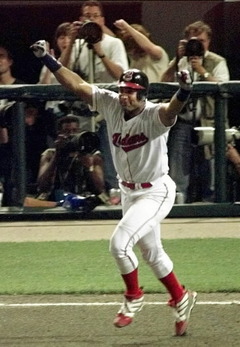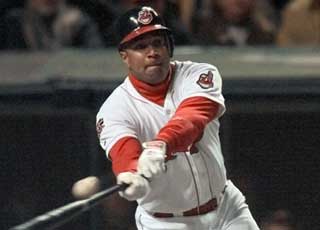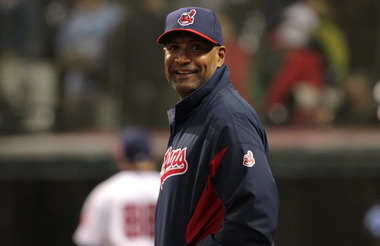 General
General  General Archive
General Archive  Top Cleveland Sports Figures, By the Numbers - #15
Top Cleveland Sports Figures, By the Numbers - #15
This is one installment in a team effort by The Cleveland Fan, highlighting the top local sports figures by jersey number. Please weigh in with your thoughts on the Boards. And as David Letterman would say, “For entertainment purposes only; please, no wagering.”
 “You have to play with pride -- for the game and for yourself. You have to go out and give a major-league effort. If you're 0-for-3 but make a major-league effort, you can go home and say, 'I gave it what I had.’” – Sandy Alomar
“You have to play with pride -- for the game and for yourself. You have to go out and give a major-league effort. If you're 0-for-3 but make a major-league effort, you can go home and say, 'I gave it what I had.’” – Sandy Alomar
Catchers tend to hold a special place in the hearts of baseball fans. Catchers have to play without fear. More often than not, they appear to be the heart and soul of the team, assuming a leadership role, both by example and by words. The catcher position is one that takes enormous dedication, both to one’s teammates and one’s own body. One could argue that catchers are the most important players on the team because they have to be involved in every facet of the game and every pitch when the team is on defense. Santos Alomar Jr. was one of the best in Cleveland Indians history.
Sandy Alomar Jr. was not the face of the Indians of the 1990s, but he may very well have been the team’s heart. One of the most perceptive and aware players to play for the Indians, Alomar had the tough task of handling a pitching staff full of mediocrity through the steroid era and doing so with bad knees. Alomar never had enough plate appearances in a season to qualify for the hitting leaderboards, so it’s hard to say what he could have become as a hitter had it not been for the consistent injury problems.
It’s no surprise that Alomar is now an up-and-coming star in the coaching world. He was always a studious player, who prided himself on effort before, during, and after the game. Perhaps more than anything, the success in Alomar’s career, both as a player and as a coach, is a testament to his unwillingness to quit. Through minor league struggles and nagging knee pain, Alomar persevered through a 24-year playing career that ended at age 41.
It’s that competitive spirit, along with 11 productive seasons in Cleveland, that makes Sandy Alomar Jr. the top #15 in Cleveland sports history.
Growing up with a father in the Major Leagues and a more athletic younger brother, Sandy Alomar was exposed to pressure at an early age. Alomar, who is 6-foot-5 and was around 200 pounds during his playing days, was the son of a 5-foot-9, 140-pound middle infielder. Sandy’s brother Robbie was destined to be the middle infielder, while Sandy had to pick a different position on his path to the Major Leagues. He opted to be behind the plate, though the transition was anything but smooth.
Despite Sandy Alomar Sr. never playing for the organization, the San Diego Padres scooped up both Sandy and his brother in the mid-1980s as international free agents. The elder Alomar brother began his professional career in 1984, suiting up in 59 games for the Single-A Northwest League Spokane Indians. The transition was difficult for Alomar, batting just .215 in 239 plate appearances. More than the offensive struggles, Alomar committed seven errors and allowed 10 passed balls in just 52 games behind the dish. The hardships continued the following year, as Alomar batted .207 for the Single-A South Atlantic League Charleston Rainbows, with 14 more passed balls and 18 errors in 100 games.
Even with Alomar’s poor numbers, the Padres kept moving him up the ranks, sending him to Double-A to play with the Beaumont Golden Gators of the Texas League in 1986. Alomar, again, had difficulties, batting .240 and committing 18 errors. In 1987, the Alomar boys got to play together for the Texas League’s Wichita Pilots. Perhaps being separated had taken a toll on Sandy, because with his brother in the same clubhouse, his batting average jumped to .307 and he cut down on his problems behind the plate.
 The two brothers again, simultaneously, moved up the ranks, winding up in Sin City with the Las Vegas Stars of the Pacific Coast League. For Sandy, the Major Leagues were finally on the horizon. With renewed confidence, Sandy hit .297, again cut down on defensive miscues, and got to celebrate with his brother, who made his Major League debut on April 22, 1988. Robbie would not play another minor league game until 2004.
The two brothers again, simultaneously, moved up the ranks, winding up in Sin City with the Las Vegas Stars of the Pacific Coast League. For Sandy, the Major Leagues were finally on the horizon. With renewed confidence, Sandy hit .297, again cut down on defensive miscues, and got to celebrate with his brother, who made his Major League debut on April 22, 1988. Robbie would not play another minor league game until 2004.
Sandy got the call on September 30, 1988. He struck out in his only at bat, a ninth-inning pinch hit appearance against Brian Meyer with two runners on base. He was sent back to Triple-A Las Vegas the following season. Rather than sulk about the demotion while his brother enjoyed Major League life, Sandy had his best minor league season, batting .306 with 101 runs batted in. His success in 1989 would make him Baseball America’s fifth-ranked prospect entering the 1990 season.
The Padres, however, had a choice to make. In 1987, Padres catcher Benito Santiago won the National League Rookie of the Year award. He won Gold Glove awards in 1988 and 1989, along with being selected to the 1989 All-Star team. The decision was to use Sandy Alomar Jr. as a very talented backup to Santiago or trade him and attempt to get some help for another area on the ballclub. Their choice was one of the best trades in Indians history.
The Indians had a 29-year-old outfielder named Joe Carter, who had just hit 35 home runs for the Tribe and the Padres had a need for outfielders. The two teams struck a deal that sent Carter to San Diego in exchange for Alomar, Carlos Baerga, and Chris James. Carter would play just one season for San Diego before being traded to Toronto. Baerga and Alomar became a part of the Indians’ core group that would take the team from irrelevance to prominence.
Alomar became an instant hit in Cleveland, being named to the 1990 All-Star team in his first full season in the Major Leagues and won the 1990 American League Rookie of the Year Award. He even won the 1990 American League Gold Glove award. But, Alomar’s success was short-lived and his perseverance was put to the test again. From 1991-1993, he battled various injuries, playing just 204 games over those three seasons. While Robbie was a two-time World Series winner with the Blue Jays, Sandy was trying his best to stay healthy and be a productive player.
Like he already had so many times before, Alomar bounced back. From 1994-1997, he played 398 games, which would have been more had it not been for the labor strike that took up parts of 1994 and 1995. Alomar batted .294 over that four-season stretch, with 56 home runs, 211 RBI, and participated in two All-Star Games. One in particular, 1997, is a memory that Indians fans will never forget.
The 1997 All-Star Game was in Cleveland, at beautiful Jacobs Field. The Indians were well-represented, with Jim Thome, Albert Belle, David Justice, and Alomar on the roster. Alomar replaced starting catcher Ivan Rodriguez at the top of the sixth, entering the game defensively in the midst of a 1-0 pitchers’ duel. He watched as Javier Lopez’s seventh inning homer tied the game at one.
Alomar entered the Midsummer Classic with a 30-game hitting streak. With two outs, Bernie Williams advanced to second on a wild pitch. With the go-ahead run on second, Alomar had the chance to put the American League in front. In lieu of trying to use words to describe the moment, it’s best to let it just speak for itself:
alt=""
Alomar won the Most Valuable Player award for the All-Star Game.
To say that 1997 was the best year of Alomar’s career would be a massive understatement. Statistically, it was Alomar’s best season, batting .324/.354/.545/.900 over 480 plate appearances, the second-most in his career, trailing only his first full season with the Indians. Alomar batted .383 from May 25 through July 6, during his 30-game hit streak.
 Along with the All-Star Game home run, Alomar had another big moment at Jacobs Field during the 1997 postseason. Facing Mariano Rivera, with the Indians trailing 2-1 in the eighth inning in Game Four of the 1997 American League Division Series, Alomar hit a game-tying solo home run to right field on a 2-0 count. The Indians would win the game in walk-off fashion in the ninth, win Game Five, and carry the momentum all the way to the World Series.
Along with the All-Star Game home run, Alomar had another big moment at Jacobs Field during the 1997 postseason. Facing Mariano Rivera, with the Indians trailing 2-1 in the eighth inning in Game Four of the 1997 American League Division Series, Alomar hit a game-tying solo home run to right field on a 2-0 count. The Indians would win the game in walk-off fashion in the ninth, win Game Five, and carry the momentum all the way to the World Series.
If given the chance, Alomar would probably trade it all in for a World Series ring. Prior to the 1997 World Series, Alomar had batted just .200 in six previous playoff series. There’s a good chance that Alomar would have been the 1997 World Series Most Valuable Player had the Indians finished the job. Against the Florida Marlins, Alomar posted a .367/.406/.600/1.006 slash line in the series, with two home runs and 11 RBI.
Alomar became a free agent after the 2000 season and signed with the White Sox. He finished his Indians career with 985 games played over 11 years and a .273 batting average. Alomar returned to an Indians uniform in 2010 when then manager Manny Acta named Alomar his first base coach and catching instructor. Alomar later became Acta’s bench coach. When Acta was fired in September 2012, Alomar served as the interim manager for the final six games of the season. He interviewed for the 2013 managerial opening before the Indians hired Terry Francona. Alomar, still a fan favorite, remains on the staff as the bench coach.
 In some ways, the city of Cleveland grew to love Sandy Alomar because he embodied Cleveland as a city. He was a hard worker who fought for every opportunity. Sandy never openly showed any jealousy or envy towards his brother Robbie and all of the success he had, including being named to the Baseball Hall of Fame in 2012. He kept his head down and grinded out a solid Major League career, in spite of rarely, if ever, playing the game healthy. He didn’t have the on-field issues that Robbie had, played the game the right way, and has always been approachable to fans, the media, his teammates, and has continued that as a coach.
In some ways, the city of Cleveland grew to love Sandy Alomar because he embodied Cleveland as a city. He was a hard worker who fought for every opportunity. Sandy never openly showed any jealousy or envy towards his brother Robbie and all of the success he had, including being named to the Baseball Hall of Fame in 2012. He kept his head down and grinded out a solid Major League career, in spite of rarely, if ever, playing the game healthy. He didn’t have the on-field issues that Robbie had, played the game the right way, and has always been approachable to fans, the media, his teammates, and has continued that as a coach.
For his accomplishments on the field, the memories he gave us, and the way he is still appreciated in Cleveland, Sandy Alomar is a great choice for #15 on the top Cleveland sports figures by number countdown.
Honorable Mention:
Jock Callander –Cleveland hockey and Jock Callander were synonymous. Although Callander was at the tail end of his career, Callander played for the Cleveland Lumberjacks of the International Hockey League from 1993-2000. Callander, who retired as the all-time leading point scorer in the International Hockey League, did most of his damage with the Lumberjacks when they were in Muskegon, MI.
Callander’s tenure in Cleveland covered 547 games over seven seasons. He scored 495 points, including postseason, over that span. In 20111, the Lake Erie Monsters of the American Hockey League honored Callander during a pre-game ceremony, raising his #15 to the rafters at Quicken Loans Arena.
Callander was part of the 1992 Stanley Cup champion Pittsburgh Penguins, the NHL affiliate of the Lumberjacks franchise. He still resides in Cleveland and is currently an assistant coach for the Lake Erie Monsters.
Johnny Allen – Johnny Allen was a fine pitcher for the Indians from 1936-1940, posting a 67-34 record with a 3.65 ERA. In five seasons, he threw 929.2 innings and made one All-Star team (1938). In 1937, Allen posted a 15-1 record with a 2.55 ERA and threw complete games in 14 of his 20 starts and was named the Major League Player of the Year.
- NBA Announces 2013-2014 Schedule
- Browns Ink Sharknado
- Sharknado A No-Show For Rookie Camp
- Trent Richardson Out Until Training Camp
- Browns Sign Brandon Jackson
- Carrasco Suspended Eight Games
- Browns Add to Wide Receiver Depth with David Nelson
- Browns Need to Learn from Past Draft Mistakes
- Browns Release Chris Gocong and Usama Young
- Browns Missing on Grimes Disappointing, But Not The End
The TCF Forums
- Movies coming out
rebelwithoutaclue (Tuesday, January 21 2014 12:56 PM) - 2015 Recruiting
jclvd_23 (Tuesday, January 21 2014 12:38 PM) - The 2014 Offseason Thread
Larvell Blanks (Tuesday, January 21 2014 12:25 PM) - Official- Browns Coach Search/Rumors
Larvell Blanks (Tuesday, January 21 2014 11:53 AM) - Chris Grant's first 3 drafts
Kingpin74 (Tuesday, January 21 2014 10:13 AM) - Mike Brown
YahooFanChicago (Monday, January 20 2014 11:15 PM) - 2014 Hoops Hockey Hijinx
jpd1224 (Monday, January 20 2014 4:44 PM) - 2014 Recruiting
jclvd_23 (Monday, January 20 2014 2:26 PM) - Wish List - #4 Pick
Hikohadon (Monday, January 20 2014 1:26 PM) - #1 overall pick Anthony Bennett
TouchEmAllTime (Sunday, January 19 2014 1:28 PM)


